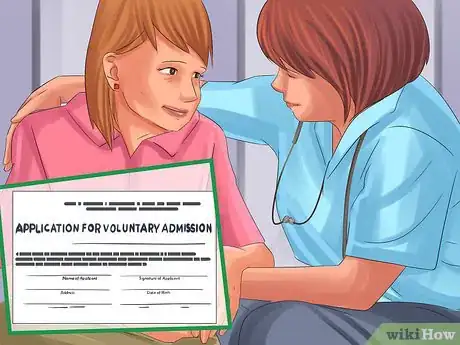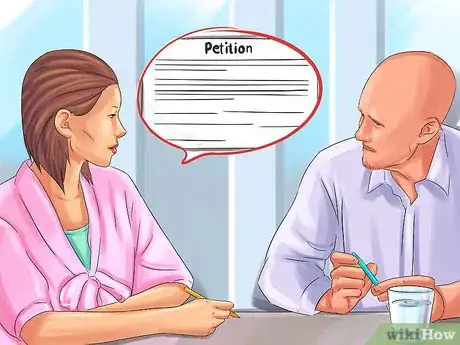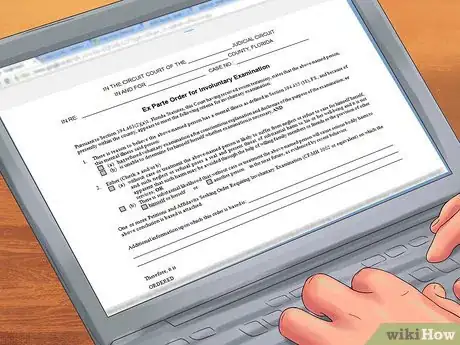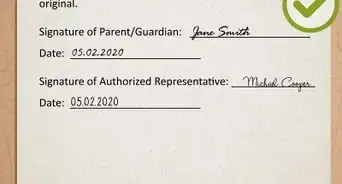This article was co-authored by Clinton M. Sandvick, JD, PhD. Clinton M. Sandvick worked as a civil litigator in California for over 7 years. He received his JD from the University of Wisconsin-Madison in 1998 and his PhD in American History from the University of Oregon in 2013.
This article has been viewed 18,423 times.
The Baker Act is the Florida Mental Health Law in the state of Florida. It is named for Maxine Baker, a state representative who worked to strengthen the rights of mental patients.[1] If you believe you need mental care, you know someone who you believe needs to be committed for his or her own safety, or you’re on the opposite side and someone else is taking (or has taken) steps to have you committed, there are certain rights that you have and certain procedures to follow. The Baker Act is designed to protect the patient's rights and provide the necessary care.
Steps
Submitting to a Voluntary Mental Health Examination
-
1Present yourself to a local hospital or care facility. If you believe that you are suffering from some mental illness and require treatment, you may voluntarily have yourself examined. This examination may lead to additional ongoing treatment, as either an inpatient or an outpatient, depending on your level of need.[2]
- When you arrive at a hospital or mental care facility, you will be provided with a form entitled, “Application for Voluntary Admission of an Adult.” This form asks you to explain briefly why you are applying for admission.[3]
- The process for voluntary examination applies to adults. If a minor wishes to be examined for mental treatment, the minor’s parent or guardian must make the application.
-
2Review your rights as a person on voluntary status. When you voluntarily report to the hospital, you must receive a written explanation of your rights as a person on voluntary status. If you do not receive such a written statement, ask for it. Read it over carefully and make sure that you understand it. If there are any details that you do not understand, ask someone to explain them to you. By signing the Voluntary Admission form, you are verifying that you are aware of your rights and that you consent.[4]Advertisement
-
3Be aware that your voluntary admission could change to involuntary. It is possible that after you check in voluntarily, a physician may determine that you need to be retained involuntarily. You need to realize this before appearing. If you request to be discharged from the hospital, but a physician believes you should remain, the hospital may hold you for up to 24 hours for further evaluation. If during that time someone files a petition in court for involuntary placement, you may be held for up to two business days pending a hearing.[5]
-
4Sign the admission form as a competent adult. After you have received notice of your rights, and have been warned of the potential for involuntary commitment, you need to sign the Voluntary Admission form in the presence of a witness. Someone at the intake desk at the hospital will witness the form.[6]
- Part of signing the admission form is an acknowledgment that you may be billed for any treatment or services you receive. It is important that you check with your insurance provider before taking this step, to make sure that you know what treatment is covered, or that you can afford to pay for whatever is not covered.[7]
Receiving Ongoing Voluntary Mental Care
-
1Provide informed consent for treatment. You have the right to receive ongoing mental health care or treatment on a voluntary basis, as needed. After you present yourself for care, and the hospital has conducted the initial examination, you will receive such treatment as your doctor deems necessary. As long as you are mentally competent to make decisions about your care, you will be informed about any course of treatment or medication and will be asked to provide consent.[8]
-
2Receive a statement from the doctor of your competence. Within 24 hours after you voluntarily admit yourself for care, your admitting physician must make a determination that you are mentally competent to make decisions regarding your care. This determination must be documented in writing and placed in your file.[9]
- If the physician does not provide this documented statement, then he or she must begin the proceedings to have your voluntary placement converted to involuntary placement.
-
3Understand your plan of treatment. Before you give informed consent, the hospital must provide you with a full understanding of the expected course of treatment. You need to be provided with the following information regarding the plan of your treatment:[10]
- the reason for your admission. Whether you initially arrived voluntarily or involuntarily, if you are mentally competent, the hospital staff must inform you of the medical reason for your treatment. You may have reported that you “don’t feel right” or “feel overwhelmed” when you reported voluntarily. The hospital will need to give you a more accurate medical explanation.
- the proposed treatment. The hospital staff must explain to you what they intend for you, whether it is counseling, medication, or some combination.
- alternative treatments. You need to be informed of other possible forms of treatment. If you have questions about those, and why they are not being considered, you have the right to ask.
-
4Learn about any planned medications. If part of your treatment is to include administration of certain medications, the staff must inform you of what those medications are, what their effects are, and what they are designed to do. If there are alternatives, you are entitled to know about them.[11]
- Ask about any side effects that may be expected with the medication you will receive.
- Ask about the effects of alternative medications that are not being used, and make sure that you understand the differences.
-
5Discuss the plan for ending treatment. Part of consenting to a plan of treatment includes understanding, in advance, when that treatment is expected to end. If you received a cast for a broken arm, it would be natural for the doctor to tell you that the cast will need to stay on for about six weeks. Similarly, with mental health care, the doctor should be able to give you an idea of the expected length of treatment.[12]
- Understand that mental health care is not always as clearly defined as other medical care, so the doctor may not be able to give you as clear an expectation as for a broken bone. But you should be able to get some idea, whether the treatment will be for a number of weeks, months or years.
- Ask about the doctor’s plan for monitoring your ongoing development, and how the decision is to be made about eventually ending treatment.
- You are entitled to know about any potential negative effects that may come from stopping treatment prematurely. If you are admitted to inpatient care, and you eventually wish to be discharged, you should know what may come from leaving care too soon.
-
6Obtain a discharge. If you do not consent to the treatment plan that the doctor proposes, and if you are not deemed incompetent, then the hospital must discharge you. Alternatively, if you refuse to consent to the treatment, the hospital may take steps to commit you involuntarily, but this decision must be made within 24 hours.[13]
Shifting from Voluntary to Involuntary Status
-
1Obtain a ruling from a court. After a person has been examined, whether that person arrived voluntarily or involuntarily at the mental care facility, the hospital may determine that the person needs to be committed involuntarily. For this to happen, the attending physician must submit a petition to a court for a ruling.[14]
- Involuntary placement can only occur after the initial examination and a court hearing.
-
2Understand the criteria for involuntary placement. In order for a court to order you to be held involuntarily for treatment, the court must examine four well-defined factors. If you are trying to challenge an involuntary placement, you need to understand the factors in the decision, and then challenge the validity of one or more of them. The four factors are:[15]
- you have refused voluntary placement or are unable to make the competent decision for yourself;
- without treatment, you are likely to suffer neglect, because you are unable to care for yourself;
- there is substantial likelihood that you will cause severe bodily harm to yourself or others;
- other, less restrictive courses of action have been considered and have been ruled out as being insufficient.
-
3Demand sufficient evidence for a court ruling on involuntary placement. For a court to make an involuntary placement, the court must find that the evidence presented is precise, explicit, lacking in confusion, and that it produces a firm belief without hesitation.[16]
- The court must hear from doctors who have actually examined you. Expert testimony from uninvolved doctors is insufficient to make an involuntary commitment.
-
4Demand a copy of the petition for involuntary placement. If you are the subject of a doctor’s petition for involuntary placement, the doctor must provide you with a copy of the petition at the time that it is filed with the court. If the subject is a minor or has been placed in the care of a guardian, then the parent or guardian must receive a copy. [17]
-
5Consult with your attorney. Within one business day of the filing of a petition, the court must appoint a public defender to represent you. If you have your own attorney, you are entitled to consult with that attorney. The attorney must be allowed access to all hospital records related to your case and the filing of the petition.[18]
-
6Request a continuance of the hearing, if you wish. You are entitled, upon the advice of your attorney, to request that the commitment hearing be continued once, for up to four weeks. This time is intended to allow you and your attorney to review the medical evidence and prepare for the hearing.
- You need to realize that during this continuance, the hospital has the right to continue to hold you in its care.
-
7Obtain an independent evaluation. During the time of the continuance, you are entitled to an independent evaluation by a physician of your own choosing. If you cannot afford an expert evaluation, the court will appoint an independent expert to conduct the examination.[19]
-
8Decide if you wish to attend the hearing. A hearing must be conducted within five business days, unless you request a continuance. You have the right to attend that hearing. Alternatively, you may choose not to attend and have your attorney represent your interest alone. At the hearing, the court will hear evidence from both sides on the issue of your mental health, ability to care for yourself, and danger to self or others.
-
9Receive the court’s decision. At the end of the hearing, the judge will make a final decision based on the evidence that was presented. The judge may decide to discharge you or commit you to the care facility for up to six months. [20]
- If the judge believes that the facility where you have already been taken is adequate, he or she may order that you remain there.
- If the judge believes another facility would be more appropriate, you may be ordered to be transferred.
-
10Ask for a discharge if the need for placement no longer exists. If you have been involuntarily committed, and after some time the reason no longer exists, you can ask to be discharged. Upon your request, the mental care facility must take one of the following three actions:[21]
- Determine that you are improved and grant a discharge. (This may not apply if you are under a criminal charge, in which case you will be transferred to a law enforcement facility.)
- Transfer you from involuntary to voluntary status, and continue an appropriate course of treatment.
- Place you on convalescent status at a community care facility. This would be for a person who no longer needs the intensive mental health care, but who is not able to live alone.
Sending Someone for an Involuntary Examination
-
1Obtain the Petition and Affidavit. Rather than presenting yourself for mental health care, you may know someone who you believe needs to be examined. This process begins by completing a Petition and Affidavit Seeking Ex Parte Order Requiring Involuntary Examination. This form is available online.
- “Ex parte” is a legal term that means you will be submitting this form to a court for a decision, without involving the person you are seeking to have examined.
- You are not required to use this specific form. You may write out your own petition that states the relevant facts for examination. However, the form is recommended by the Department of Children and Families because it is designed to include all the information that you will need.
-
2Complete the Petition and Affidavit. The Petition and Affidavit is your statement to the court that you believe someone you know should be taken by law enforcement for a mental examination. You need to know that you are completing the form under oath, and the completed form will be made available to the person you are trying to have examined. Your statements must be completely truthful.
- First, you will be asked to provide information identifying yourself. This includes your name, home and work addresses, and your relationship to the person you are writing about.
- The next series of questions asks about any history you have regarding the Baker Act, whether you have filed reports about this person before, or whether the person has filed reports about you.
- The remainder of the form is optional and gives you the chance to report whatever behaviors you have witnessed that you believe supports having the person involuntarily examined. The more information you can provide, the better the judge’s decision will be.
- Finally, you are asked to provide identifying information about the person who is the subject of the form. You are asked to give the person’s name, physical description, and your assessment of whether the person is currently dangerous to himself or others. If you know that a legal guardian has been appointed, you are asked to provide that information as well.
-
3Sign the Petition and Affidavit under oath. You need to sign the form in the presence of a notary public, who can verify your identity at the time of signing, or in front of the clerk of the court when you file it. So if you do not have access to a notary, then do not sign the form until you go to court and are ready to file it. Ask the clerk for instructions.
-
4File the Petition and Affidavit in court. You need to take the completed form to the court clerk for the county in which the person resides. The clerk will accept the form and get it to a judge for review and approval. You may need to speak to the judge to answer any questions about the form and your knowledge of the person.[22]
- After you file the Petition and Affidavit, your role is over. The court will consider your petition and act on it. If the petition is granted to have the patient examined, a law enforcement officer will find the person and transport him or her to a receiving facility for examination.
- The involuntary petition for an examination may also be completed by a law enforcement officer who observes behavior that leads him or her to believe that the subject needs to be examined. Finally, it may also be completed by a physician who believes that the person meets the criteria for a mental health examination.
Asserting Your Rights as a Patient Under the Baker Act
-
1Demand to be informed about your treatment. As a patient under the Baker Act, you have a right to make informed consent. Informed consent is the right to know the risks of the proposed treatment and the alternative treatment.[23]
- Mental health treatment often includes the use of mental health drugs. Mental health drugs carry FDA warnings such as hallucinations, mania, psychosis, delusions, paranoia, suicidal and homicidal thoughts. Medical causes such as nutritional deficiencies, hormonal imbalances, thyroid imbalances and tumors, can be evidenced by medical tests and can be treated with traditional medical care that does not include the use of the mental health drugs.
-
2Demand your right to open communications. Whether you are being cared for voluntarily or involuntarily, you have the right to talk on the phone with your family, your friends, and your attorney/advocate. The care facility must notify you when the phone will be made available to you to do so.[24]
-
3Ask when visiting hours are. You have the right to visitors during visiting hours.
-
4Choose a representative. You have the right to a representative to assist you throughout your mental health treatment. The Baker Act provides you this right and includes a list of those who are eligible to be your representative and help you assert your rights:[25]
- Your spouse
- An adult child
- A parent
- Next of kin
- An adult friend
-
5File a Writ of Habeas Corpus. If you believe that you have been wrongfully detained, you have the right to formally file a paper with the court that questions the legality of your commitment. For this, you will need to rely on your attorney or representative. The writ of habeas corpus needs to be filed in the courthouse of the county where you are being detained and will cause a hearing to review the evidence and procedures surrounding your commitment.[26]
-
6Follow up if needed. You could also file a complaint with the Agency for Health Care Administration or Florida Department of Health if you feel the facility has violated regulations. You can contact a Baker Act Attorney and/or a Mental Health Rights Advocate if you want assistance in asserting your rights or if you want help in filing appropriate complaints.[27]
References
- ↑ http://www.ninthcircuit.org/sites/default/files/TheBakerAct-English.pdf
- ↑ https://www.tpoftampa.com/what-is-the-baker-act/
- ↑ https://www.tpoftampa.com/what-is-the-baker-act/
- ↑ https://omh.ny.gov/omhweb/forensic/manual/pdf/omh472.pdf
- ↑ http://bakeract.fmhi.usf.edu/document/2014BakerActManual.pdf
- ↑ https://omh.ny.gov/omhweb/forensic/manual/pdf/omh472.pdf
- ↑ https://omh.ny.gov/omhweb/forensic/manual/pdf/omh472.pdf
- ↑ http://bakeract.fmhi.usf.edu/document/2014BakerActManual.pdf
- ↑ http://bakeract.fmhi.usf.edu/document/2014BakerActManual.pdf
- ↑ http://bakeract.fmhi.usf.edu/document/2014BakerActManual.pdf
- ↑ http://bakeract.fmhi.usf.edu/document/2014BakerActManual.pdf
- ↑ http://bakeract.fmhi.usf.edu/document/2014BakerActManual.pdf
- ↑ http://bakeract.fmhi.usf.edu/document/2014BakerActManual.pdf
- ↑ http://bakeract.fmhi.usf.edu/document/2014BakerActManual.pdf
- ↑ http://bakeract.fmhi.usf.edu/document/2014BakerActManual.pdf
- ↑ http://bakeract.fmhi.usf.edu/document/2014BakerActManual.pdf
- ↑ http://bakeract.fmhi.usf.edu/document/2014BakerActManual.pdf
- ↑ http://bakeract.fmhi.usf.edu/document/2014BakerActManual.pdf
- ↑ http://bakeract.fmhi.usf.edu/document/2014BakerActManual.pdf
- ↑ http://bakeract.fmhi.usf.edu/document/2014BakerActManual.pdf
- ↑ http://bakeract.fmhi.usf.edu/document/2014BakerActManual.pdf
- ↑ http://www.ninthcircuit.org/sites/default/files/TheBakerAct-English.pdf
- ↑ http://bakeract.fmhi.usf.edu/document/2014BakerActManual.pdf
- ↑ http://bakeract.fmhi.usf.edu/document/2014BakerActManual.pdf
- ↑ http://bakeract.fmhi.usf.edu/document/2014BakerActManual.pdf
- ↑ http://bakeract.fmhi.usf.edu/document/2014BakerActManual.pdf
- ↑ http://bakeract.fmhi.usf.edu/document/2014BakerActManual.pdf





















































































Medical Disclaimer
The content of this article is not intended to be a substitute for professional medical advice, examination, diagnosis, or treatment. You should always contact your doctor or other qualified healthcare professional before starting, changing, or stopping any kind of health treatment.
Read More...